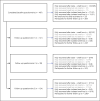Sustained Chemosensory Dysfunction during the COVID-19 Pandemic
- PMID: 33789309
- PMCID: PMC8089463
- DOI: 10.1159/000515132
Sustained Chemosensory Dysfunction during the COVID-19 Pandemic
Abstract
Introduction: Chemosensory dysfunction (CD) has proven valuable in prediction of COVID-19, as it is a frequent and specific symptom of the disease. The aim of this study was to investigate the duration of CD in patients with sudden subjective olfactory and/or gustatory loss during the SARS-CoV-2 pandemic. The secondary aim was to identify possible prognostic factors for the duration of CD.
Methods: An online baseline questionnaire was designed to assess subjective CD. Three rounds of follow-up questionnaires were sent out to any participants with persistent CD in 6-week intervals, prospectively assessing subjective chemosensory function and extending the follow-up time of this cohort significantly.
Results: In total, 467 participants completed the baseline questionnaire. The most significant improvement and recovery of chemosensory function was observed within the first month after the initial loss. Rates became stagnant after about 2 months, and only little improvement and recovery was seen after 2-4 months. After a mean follow-up of 95.9 days (olfactory dysfunction) and 94.0 days (gustatory dysfunction), 86.7% of participants reported gustatory improvement and 82.6% reported olfactory improvement, while 55.0% reported full gustatory recovery and 43.8% reported full olfactory recovery. Female gender was associated with better improvement of gustatory function. High subjective severity of chemosensory loss was associated with lower rates of olfactory and gustatory recovery as well as improvement of olfactory function. Young age was not associated with a better prognosis.
Discussion/conclusion: Rates of improvement and recovery of chemosensory function decreased after 2-4 months after initial chemosensory loss, possibly indicating that prolonged and perhaps permanent chemosensory loss may be a complication of SARS-CoV-2 infections. High subjective severity of CD may worsen the prognosis for improvement and recovery of chemosensory function.
Keywords: COVID-19; Chemosensory loss; Prognosis; Smell; Taste.
© 2021 S. Karger AG, Basel.
Conflict of interest statement
The authors have no financial disclosures or conflicts of interest.
Figures



References
-
- World Health Organisation Coronavirus disease (COVID-19) 2020. [cited 2020 Oct 30] Available from: https://www.who.int/emergencies/diseases/novel-coronavirus-2019/question....
MeSH terms
LinkOut - more resources
Full Text Sources
Other Literature Sources
Medical
Miscellaneous

